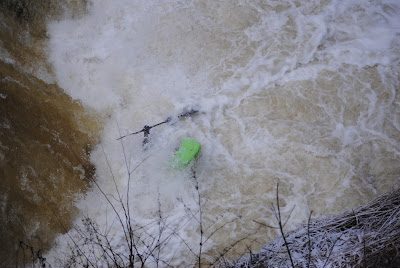Bridge Day on the New River is something to behold. Most
experience it from the deck of the New River Gorge Bridge about 900 feet above
Fayette Station rapid. The lucky few witness it from the water after finding
their own adrenaline rush paddling down amongst the rapids of the gorge.
Keelhaulers Phil and Jen Raber kindly organized a trip on
the gorge on the Saturday of Bridge Day 2017, helping a few other club members
navigate the crowds and closed roads to enjoy a 70-degree, partly sunny day—unusual
for late October but welcome all the same.
The trip started with some unique navigating along Keeney Creek. A brief mountain hike, some bushwhacking and a jump across a remote Amtrak line led us down to a little-used put-in just below Middle Keeney. We climbed in our boats and dropped right into Lower Keeney. The level was approaching -1 foot, but nonetheless it was still the biggest rapid of the day. Low water, but we still enjoyed all the play opportunities.
 |
| Our view on Bridge Day 2017 from Fayette Station rapid on the New River Gorge. |
The trip started with some unique navigating along Keeney Creek. A brief mountain hike, some bushwhacking and a jump across a remote Amtrak line led us down to a little-used put-in just below Middle Keeney. We climbed in our boats and dropped right into Lower Keeney. The level was approaching -1 foot, but nonetheless it was still the biggest rapid of the day. Low water, but we still enjoyed all the play opportunities.
Sooner than we expected, we were at Fayette Station
witnessing the impressive show. Every few seconds a new jumper would leap from
the bridge, open their chute and spend the next 30 to 60 seconds floating down
to Earth. The good jumpers hit the bullseye on the takeout beach. A few unlucky
souls splashed down and had to be fished out by safety boaters with some
impressive horsepower. We watched for a while and then made the 4-mile
flat water paddle to the takeout. Fayette Station Road was closed, making
it impossible to use the normal takeout below the bridge. If you can, a good
option is to leave a car the night before at the alternate takeout—access to
this is closed on the evening before Bridge Day—on river right below the gorge
bridge.
The day ended with a trip to dinner and a stop to visit the
Summersville Dam—paying homage to the source of the Gauley River release we would experience the next day—at sunset before returning to Ray’s to rest up for day two.
The first day definitely did NOT end somewhere around 10 p.m. with Nick, Phil and Jen expertly changing the
water pump on a shuttle vehicle in the parking lot of a busy truck stop.
Day two started with breakfast at Biscuit World, a scenic trip over Gauley Mountain, courtesy our tour guide and photographer extraordinaire Jeff Macklin, before setting shuttle for the Lower Gauley. Ryan Laughlin joined the rest of the group, which included Mark and Pam, Nick Conway, Victor Kopyev and Matt Fredmonsky. Nick, Ryan and Matt were all making their first descents of the Lower Gauley, and what a group to be a part of! Phil, Jen, Mark and Pam all have countless Gauley runs and know the river well. They provided the perfect amount of guidance, support, encouragement and of course solid lines to keep us all smiling with no issues. No one swam, and there were less than a handful of combat rolls. Props to Nick who, despite being a first-timer, was fearless. He put on a nice display with a rodeo ride in 5 boat hole, side-surfing his Mamba, rolling, coming back up in the hole, spinning around and finally carving out toward the center of the river and floating down with a big grin.
The rest of the run was sprinkled with huge wave trains, some nice playboat moves from Mark, impressive attainments from Phil in his green boat and otherwise happy paddlers. Trying to describe the beauty of the remote gorge with mere words would be a futile effort. Canyon Walls! The best way to describe it is to say it is a river experience like few others, one every paddler should work toward. The Gauley River offers arguably the biggest whitewater east of the Mississippi, and the last release of the season—with its sunny skies and 70-degree temperatures—did not disappoint.
 |
| Thanks to Phil I had a great line going through Koontz Flume on the Lower Gauley. |
What impressed me the most about this West Virginia weekend,
particularly the day spent on the Lower Gauley, was the way our trip leaders so
graciously took the time to introduce the first-timers to the run. What a
wonderful act of kindness! Not many of these rapids can be scouted easily, if
at all, and some pose quite serious hazards—including deadly undercuts and pin
hazards. Without good beta, this run can yield terrifying consequences if you
can’t find the right line or end up swimming. We were all thankful for their input. It truly
impressed upon me the fact that kayaking has a great tradition of passing on
knowledge from one generation to the next. And trips like these are like a
master class in navigating big water with all the challenges a river can offer.
It was a privilege to paddle with and learn from some great kayakers. I think
it’s fair to say that myself and the others look forward to the day that we
might be able to impart that kind of wisdom to more new whitewater paddlers as
they ramp up their own journeys down the river.






























